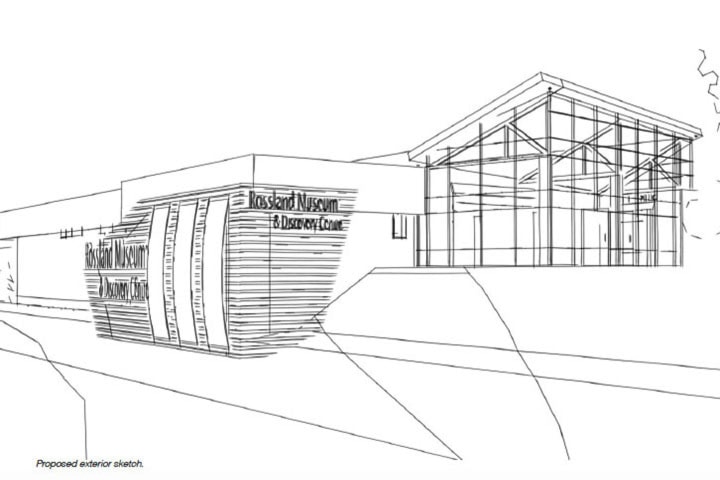The price tag on the Rossland Historical Museum’s renewal concept is sizable and is the biggest hurdle the city’s venerable facility now faces, says the museum society president.
Libby Martin said the $3-mllion estimate for the entire project is sizable, but it can be broken down into smaller, more digest-able modules so the entire vision could be achieved in stages as the money becomes available.
Charting the financial path is the key right now, and any potential museum friends to ferret out funds could be made at the next public meeting in the second week of April, Martin said.
“We’re hoping there would be some members of the community that would be interested in helping with securing some of the initial funding for the museum, some that are familiar with the granting process,” she said.
“It’s a bit of a call for knowledgeable people to help out.”
The next step for the museum advisory committee will be to figure out a funding formula, based on a combination of grants, corporate sponsorship and partnerships with senior levels of government.
The consultant hired to develop the renewal concept, Don Luxton of Vancouver, provided a list of various funding agencies.
The costs of the renewal concept have been determined through an order of magnitude for each phase that can proceed independently as required.
The priorities for the plan have been determined so that the renewal can proceed in a “logical manner” as funds are secured, Luxton’s final report read.
There is no more quibbling on the specifics of the plan, said Martin.
“We’ve pretty much agreed that we like the overall plan, it’s a question of the money,” she said. “If we get the money for the first phase, we’ll go ahead. And then we’ll go after money for the next phase.”
The renewal concept has been developed with the intention of meeting senior government criteria for funding without compromising local identity and programming.
To get there, some of the next steps include setting up a fundraising committee, initiating a capital fundraising campaign and approaching senior levels of government to determine levels of project support and appropriate funding programs.
As well, corporate and community partners will be identified, and grant applications will be initiated.
The report will go public in the second week of April, although it is available in its entirety on the city’s website.
The reason for the concept
When the city’s museum lost access to tours of the Le Roi Mine two years ago it left a hole bigger than the shafts sunk into the earth’s crust on Red Mountain.
Closed permanently over safety issues arising from the instability of the rock encasing the mining tunnels, the mine tour was the major drawing card for the museum, and its loss nearly folded the museum’s hand.
Visits to the Rossland Historical Museum plummeted as a result—dropping by over half in one year—prompting the formation of a Museum Advisory Committee to investigate a way to stop the bleeding and rehabilitate the institution.
The renewal concept
The concept includes recreating a section of underground mine tunnel (21 metres, 70 feet), complete with rocks, rails and water drips.
The renewal concept would open up the interior, creating a larger entrance gallery and adding on a full glass, well-lit atrium to welcome people into the museum.
It would include sections on geology, power, community history (including skiing and mountain biking) and the history of mining. The current ski shed section of the museum would be demolished and the ski artifacts brought into the body of the museum.
As well, the outside artifacts would be housed in an industrial shed—built in a style evoked by the time period—with level access and siting to create an outdoor stage for events and classes.
The shed would help tie together the exterior artifacts and create and secure the assets as well.
Space for research would be created, as well as centralizing storage and maximizing and rotating the exhibits on display.
The exterior could also reflect the mining history, with metal cladding—possibly zinc—adorning the exterior in a decorative way.
Signage outside of the museum and within the city would also be improved, helping direct people to the museum.
Total Budget: approximately $3 million
• Museum building: $2,085,000 for 10,700 sq. ft. = $195 psf
• Shed building: $490,000 for 1,920 sq. ft. = $255 psf
• Artificial rock, allow $200,000
• Exhibit design and fabrication, allow $225,000
Order of magnitude costs only.
• Entry gallery $240,000 (includes $100,000 demo, disposal and hoarding costs)
• Mining experience $630,000 (includes $50,000 demo/disposal costs and part of cost of metal roof across entire back of building)
Artificial rocks $200,000, includes design of tunnel and mine entrance.
• Atrium $420,000 (Atrium and mining experience could be built concurrently)
• Industrial building shed $490,000
• Screen/sign/site work/exterior walls/windows $375,000
• Interior renovations $420,000 (includes $80,000 structural and $200,000 mechanical/electrical)
